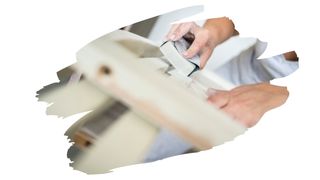Polycrylic is a fast-drying wood sealer that works wonderfully on interior wood. And a few coats of this durable finish can help prevent scratches and scrapes from marring the surface of wood.
But, as a crystal clear finish, it doesn’t really add a lot in the way of color to pale wood grain. Yet, a coat of paint can.
Still, is there a quick and easy way to get the best of both worlds by combining the two?
Well, in this post, you will learn the difference between polyurethane and polycrylic. You will also discover the two key things you must do before you apply any type of paint over Polycrylic.
And keep reading to learn why sanding Polycrylic (before you paint) is so important.

This post may contain affiliate links to products that we receive a commission for (at no additional cost to you). Learn more here.
Are Polycrylic And Polyurethane Pretty Much The Same Thing?
Almost, but not quite. They’re about as similar as Spar Urethane is to Polyurethane — as in they’re both urethane-based, but have different ingredient ratios.
While Polycrylic is a urethane-based finish, (just like polyurethane), it has a different balance to it’s base ingredients. You see, Polycrylic, (a water-based finish from Minwax), is made up of a blend of acrylic and urethane.
Now, when it comes to how well it protects wood, it works just as well as any interior-wood water-based polyurethane. And, thanks to its water-base, it dries and cures much faster than your typical oil-based polyurethane finish as well.
Related Post: Can Polycrylic Be Used To Seal And Protect Kitchen Countertops?
And Can You Paint Over Polycrylic?
Sure you can. However, there are two main caveats to applying paint over Polycrylic:
1). Always Make Sure You Wait For Polycrylic To Cure First
Paint won’t stay atop any finish that isn’t wholly dry and cured. That’s because a still-curing base coat can cause adhesion issues with that top coating paint.
2). Always Make Sure You Use Water-Based Paint Over Polycrylic
There’s a general rule of thumb when it comes to wood finishing; match like with like.
So, apply oil-based sealers over oil-based finishes. And the same goes for water-based finishes — always coat water-based sealers over water-based finishes.
And, once again, the reason for this lies in adhesion issues.
Oil and water don’t mix. And this universal rule is reflected in the way oil-based paint can peel off water-based Polycrylic.
So, if you want to paint over Polycrylic, use water-based paints such as Acrylic or Latex Paint.
Related Post: Is Polycrylic Really The Right Wood Finish For Outdoor Use?
What About Chalk Paint? Can You Paint Over Polycrylic With Chalk Paint?
Well, chalk paint is another water-based paint product. So, you can apply it over Polycrylic too.
In fact, chalk paint doesn’t need much prep — if any — pre-application. However, this particular paint does have a tendency to peel and flake if you don’t seal it.
In other words, this is the kind of paint that would need Polycrylic as a top coat (not the other way around). But, if you really want to apply chalk paint over polycrylic, it will adhere to it.
Now, one of the reasons why chalk paint is so popular is due to it’s ease of application. You often don’t need to sand, (or otherwise prep), a surface before coating chalk paint onto it.
Nonetheless, you’re still better off sanding that Polycrylic surface in preparation for chalk paint all the same. It’s simply best practice.
Related Post: Help! Why Are There Air Bubbles In My Polycrylic Finish! [+ What You Can Do To Fix It]
But Why Do You Need To Sand After Polycrylic? Can You Simply Paint Over Polycrylic Without Sanding At All?
Sanding is all about making sure paint sticks to that very smooth Polycrylic surface. And sanding with fine 220-grit sandpaper creates bits of grit for paint to cling to.
On top of that, Paint is notorious for peeling off, well, everything! And this is even more so the case when it has been applied onto a smooth surface.
So, you can either take the time to scuff up Polycrylic a bit with sandpaper, or you can use a bonding primer instead. Otherwise, you may find that paint peeling off later on down the line.
Wait A Second…What Is A Bonding Primer Again?
Bonding primers act as a binding agent between a base coat and a top coat. They’re like a glue bonding two otherwise incompatible wood finishes/sealers.
For example, Dewaxed Shellac is a popular bonding primer, since it’ll stick to just about anything. And almost anything will stick to it in return.
Related Post: Is Shellac A Good Finish For Outdoor Furniture?
To Wrap Up, Here Are The 3 Key Takeaways From This Post…
- 1). Polycrylic is a water-based finish that seals and protects surfaces in a similar way to water-based polyurethane.
- 2). You can apply water-based paints, such as Acrylic Paint or Chalk Paint, over Polycrylic.
- 3). Always lightly sand Polycrylic, (with 220 grit sandpaper), before applying any paint over it.


![Help! Why Are There Air Bubbles In My Polycrylic Finish! [+ What You Can Do To Fix It] bubbles in polycrylic finish](https://www.thewoodworkplace.com/wp-content/uploads/2022/10/Banner-490-150x150.jpg)
